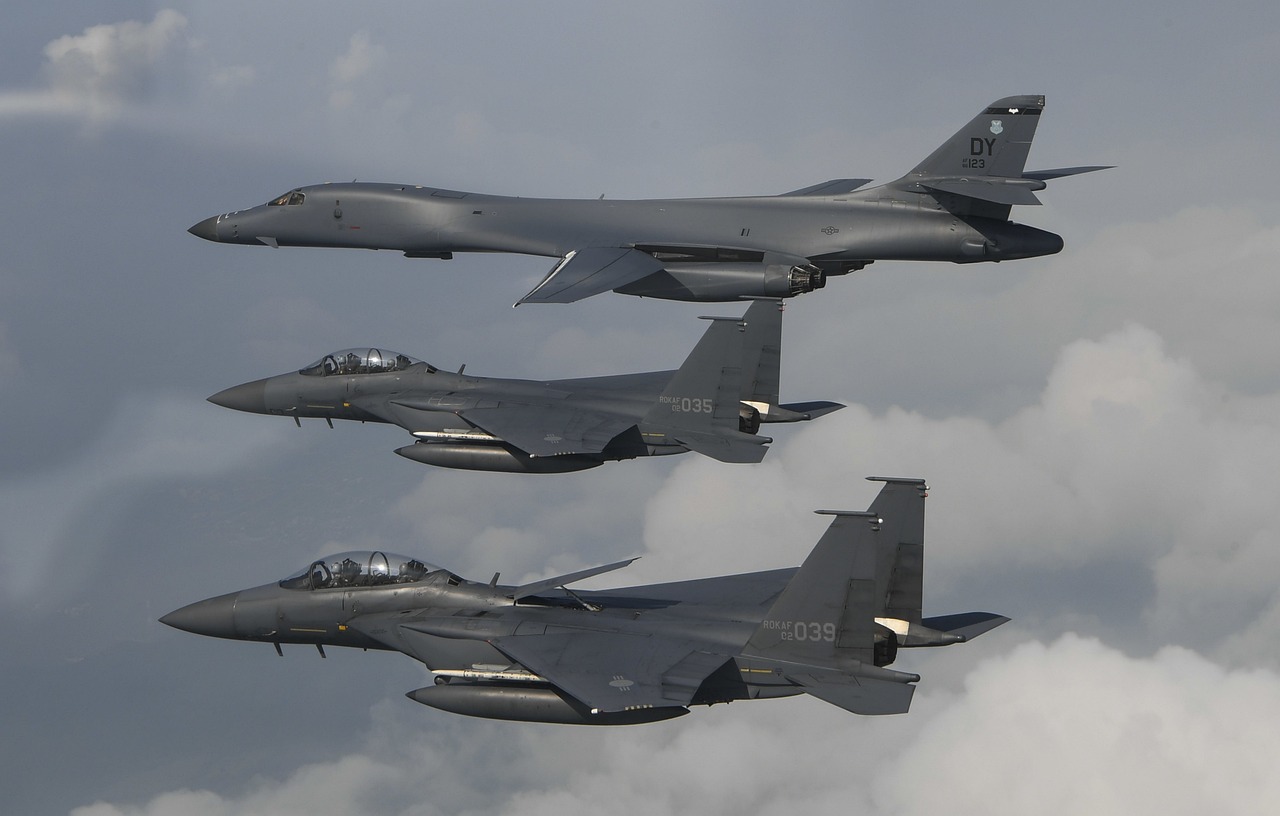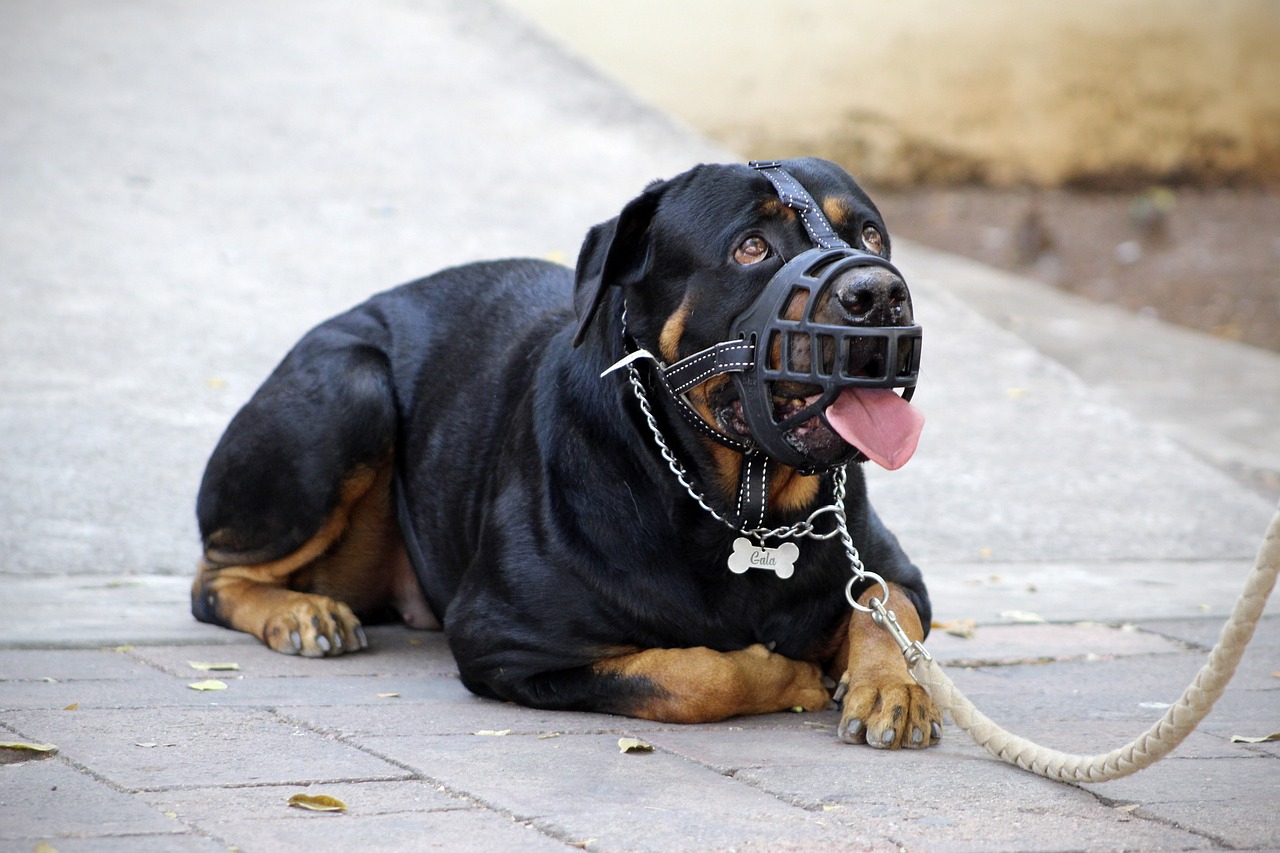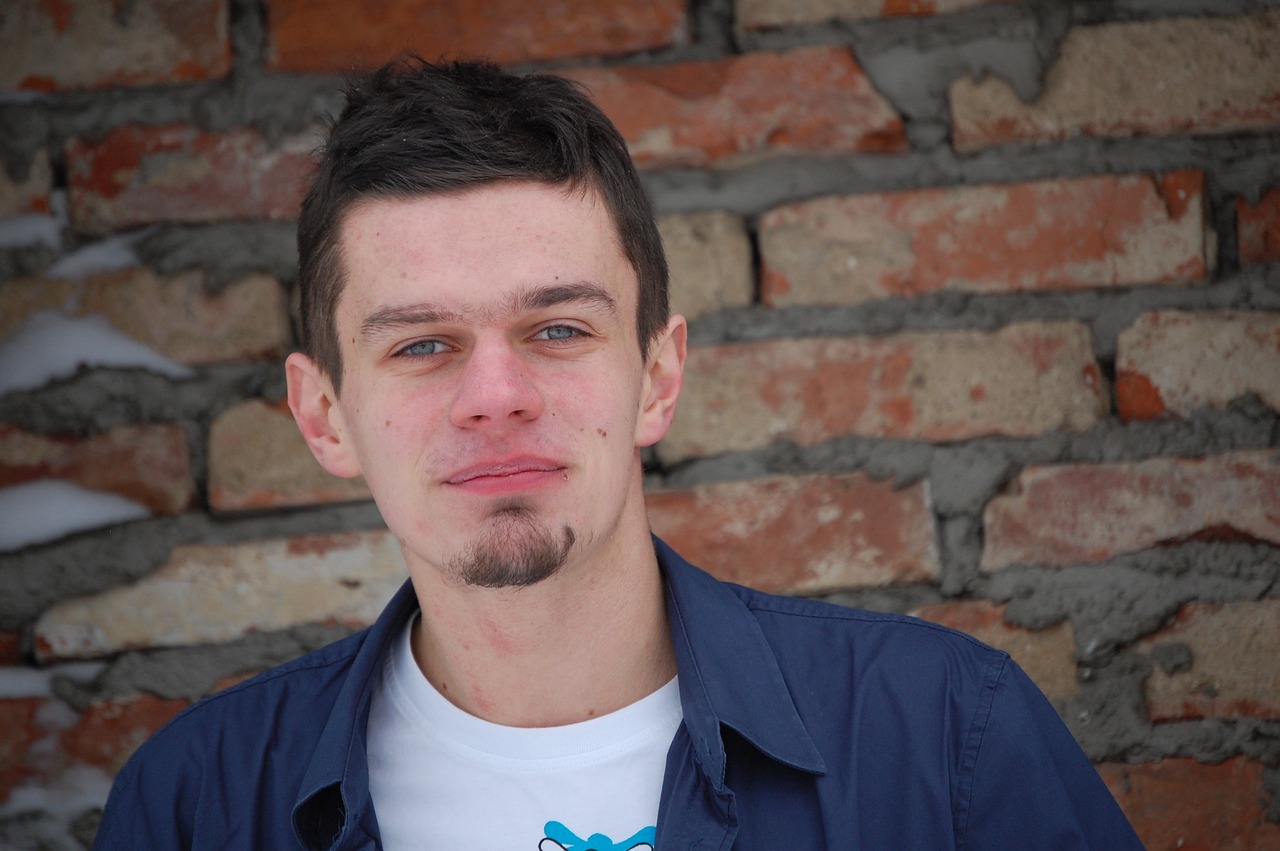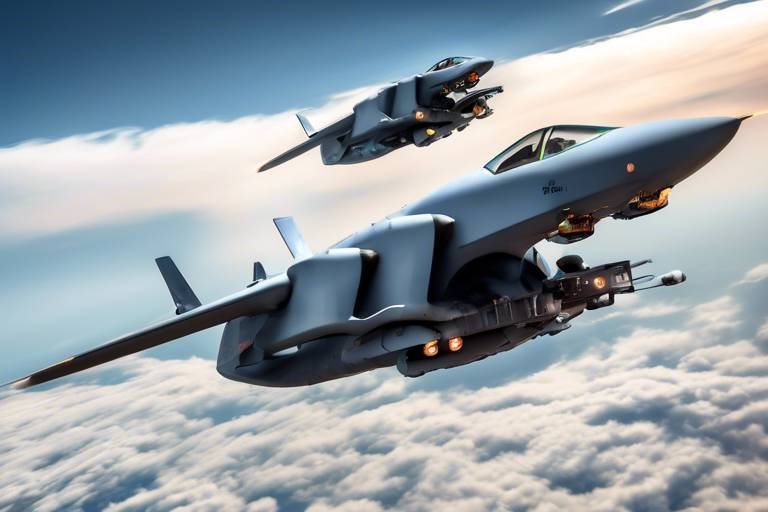The Role of Special Operations Forces in Modern Warfare
In today's world, where conflicts are as complex as they are unpredictable, the role of Special Operations Forces (SOF) has become increasingly vital. These elite military units are not just another cog in the military machine; they are the sharp edge of the spear, designed for precision, speed, and adaptability. While conventional forces are essential for large-scale engagements, SOF excels in situations that require a nuanced approach, often operating in the shadows to achieve strategic objectives that traditional forces cannot. Imagine a chess game where every piece has a specific role, but the SOF are the knights—moving in unexpected ways, creating opportunities, and striking where the enemy least expects it.
SOF's unique capabilities allow them to engage in a variety of missions, from counterterrorism to unconventional warfare, all while working closely with local forces and intelligence agencies. This adaptability is crucial in modern warfare, where the lines between combatants and non-combatants are often blurred, and where the battlefield can be a city street, a mountain range, or even cyberspace. The integration of technology and human intelligence further enhances their effectiveness, allowing them to respond to threats in real-time and with surgical precision.
Moreover, the impact of SOF extends beyond immediate military objectives; they also play a significant role in shaping national security policies and international relations. By conducting operations that stabilize regions, counter extremist ideologies, and train allied forces, SOF contributes to long-term peace and security. Their ability to adapt to changing circumstances and leverage local insights makes them indispensable in the fight against global threats.
In summary, the role of Special Operations Forces in modern warfare is multifaceted and crucial. They embody a blend of strategic foresight and tactical prowess, allowing them to operate effectively in diverse environments. As we delve deeper into the various aspects of SOF, we will uncover the historical evolution of these forces, their core capabilities, and the challenges they face in the ever-changing landscape of warfare.

[Historical Evolution of Special Operations Forces]
The journey of Special Operations Forces (SOF) is as fascinating as it is complex. Originating in the tumultuous backdrop of World War II, these elite units were initially conceived to conduct missions that traditional forces could not accomplish. Their evolution reflects a shift in military strategy, adapting to the ever-changing landscape of warfare. From covert operations behind enemy lines to high-stakes counterterrorism missions, SOF has undergone significant transformation, continuously redefining its role in modern conflicts.
During World War II, the necessity for specialized units became apparent as conventional forces faced challenges that required unconventional solutions. The formation of units such as the British Special Air Service (SAS) and the American Office of Strategic Services (OSS) marked the inception of organized special operations. These forces were tasked with missions that included sabotage, reconnaissance, and guerrilla warfare, laying the groundwork for what would become the modern SOF framework.
As the world transitioned into the Cold War, the role of SOF evolved further. The focus shifted towards counterinsurgency and anti-terrorism operations, particularly as conflicts erupted in regions like Vietnam and the Middle East. The establishment of the U.S. Army's Green Berets and the Navy's SEALs during this time was pivotal, providing a template for future special operations. Their ability to operate in small, highly trained teams allowed them to engage in complex missions that required a deep understanding of local cultures and languages.
Fast forward to the post-9/11 era, and the significance of SOF reached unprecedented levels. The attacks on September 11, 2001, ushered in a new wave of global terrorism, prompting a re-evaluation of military strategies. SOF became at the forefront of the U.S. response, leading operations in Afghanistan and Iraq that aimed to dismantle terrorist networks. The success of these missions underscored SOF's unique capabilities and their critical role in national security.
Throughout this historical evolution, several key missions stand out:
| Era | Key Missions | Impact |
|---|---|---|
| World War II | Sabotage and reconnaissance missions in Europe | Established the effectiveness of special operations |
| Cold War | Counterinsurgency in Vietnam | Refined tactics for unconventional warfare |
| Post-9/11 | Operation Enduring Freedom | Highlighted the importance of SOF in counterterrorism |
In summary, the historical evolution of Special Operations Forces is a testament to their adaptability and resilience. From their inception in World War II to their critical role in modern warfare, SOF continues to shape military strategies and national security policies. As we look to the future, understanding this evolution helps us appreciate the unique capabilities that these elite forces bring to the table.
- What are Special Operations Forces? SOF are elite military units trained to conduct high-stakes missions, including counterterrorism, reconnaissance, and unconventional warfare.
- When were Special Operations Forces first established? The concept of SOF emerged during World War II, with the formation of units like the SAS and OSS.
- How have SOF evolved over time? SOF have adapted to new warfare challenges, shifting focus from conventional combat to counterinsurgency and counterterrorism operations.
- What role do SOF play in modern conflicts? SOF are critical in executing complex missions that require specialized skills, often working alongside conventional forces to enhance operational effectiveness.

[Core Capabilities of SOF]
Special Operations Forces (SOF) are not your average military units; they are the elite warriors of modern warfare, equipped with a unique arsenal of skills and competencies that allow them to tackle a wide range of challenges. Their versatility is what sets them apart, enabling them to operate effectively in diverse combat scenarios. From unconventional warfare to counterterrorism, the core capabilities of SOF are critical in addressing the complexities of today's security landscape.
One of the defining characteristics of SOF is their proficiency in unconventional warfare. This approach goes beyond traditional combat methods, focusing instead on guerrilla tactics and psychological operations that can turn the tide of battle in favor of smaller, agile forces. Imagine a chess game where the smaller pieces can outmaneuver the larger ones, creating chaos on the board—that's the essence of unconventional warfare. SOF excels in this domain, utilizing their skills to disrupt enemy operations and sway local populations, making them invaluable in asymmetric conflicts.
Within the realm of unconventional warfare, SOF employs two primary strategies: guerrilla tactics and psychological operations. Guerrilla tactics are essential for smaller forces aiming to combat larger adversaries. By employing hit-and-run strategies, ambushes, and sabotage, SOF can effectively disrupt enemy supply lines and command structures. This not only hampers the enemy's operational capabilities but also boosts the morale of local allies who see their oppressors being challenged.
On the other hand, psychological operations are designed to influence perceptions and behaviors. SOF leverages these operations to achieve strategic objectives, such as fostering support among local communities or undermining the enemy's resolve. By crafting targeted messages and utilizing various media, they can sway public opinion and create a favorable environment for their missions. This dual approach of combining physical disruption with psychological influence underscores the multifaceted nature of SOF operations.
Another cornerstone of SOF capabilities lies in their counterterrorism operations. In an era where terrorism poses a significant threat to global security, SOF has become a frontline force in neutralizing these threats. Their operations are characterized by precision, speed, and intelligence-driven tactics. Whether it's conducting raids on terrorist strongholds or gathering actionable intelligence to prevent attacks, SOF operates with a level of effectiveness that is unparalleled.
To illustrate their impact, consider the following table that highlights some key attributes of SOF in counterterrorism:
| Attribute | Description |
|---|---|
| Precision Strikes | SOF conducts targeted operations to eliminate high-value targets with minimal collateral damage. |
| Intelligence Integration | SOF relies on real-time intelligence to adapt their strategies and ensure mission success. |
| Rapid Deployment | SOF units can be deployed quickly to respond to emerging threats globally. |
| Community Engagement | SOF works closely with local populations to build trust and gather vital information. |
In conclusion, the core capabilities of Special Operations Forces encompass a wide spectrum of skills that are essential for modern military operations. Their expertise in unconventional warfare and counterterrorism not only enhances their effectiveness on the battlefield but also plays a crucial role in ensuring national and global security. As the landscape of warfare continues to evolve, the adaptability and skillfulness of SOF will remain pivotal in addressing the myriad of threats facing nations today.
- What are Special Operations Forces? Special Operations Forces are elite military units trained to conduct unconventional warfare, counterterrorism, and other specialized missions.
- How do SOF differ from conventional forces? SOF are highly trained for specific, often high-risk missions that require agility, stealth, and specialized skills, unlike conventional forces that engage in traditional combat roles.
- What types of missions do SOF undertake? SOF undertake a variety of missions including reconnaissance, direct action, counterterrorism, and unconventional warfare.
- How do SOF integrate with conventional military units? SOF often collaborate with conventional forces through joint operations, training exercises, and coordinated strategies to enhance overall mission effectiveness.

[Unconventional Warfare]
Unconventional warfare represents a fascinating and complex aspect of military strategy that diverges significantly from traditional combat methods. At its core, it encompasses a range of tactics designed to undermine an enemy's capabilities through indirect means rather than direct confrontation. This is where Special Operations Forces (SOF) truly shine, employing their unique skill sets to navigate the murky waters of modern conflicts. Think of it as a game of chess, where the objective is not just to capture the king but to manipulate the entire board to your advantage, often without your opponent even realizing it.
SOF's expertise in unconventional warfare is pivotal, especially in environments where conventional forces may struggle. In many cases, they operate in small teams, leveraging their agility and adaptability to engage in guerrilla tactics and psychological operations. These tactics are particularly effective against larger, more conventional military forces, allowing SOF to disrupt enemy operations and influence local populations in ways that traditional forces cannot. For instance, during the Vietnam War, SOF utilized guerrilla tactics to great effect, showcasing their ability to operate in hostile environments while fostering support among local communities.
One of the most critical components of unconventional warfare is guerrilla tactics. These tactics allow smaller, less equipped forces to challenge and undermine larger adversaries. SOF units are trained to blend in with local populations, gathering intelligence and launching surprise attacks that can demoralize enemy troops. This approach not only targets military objectives but also aims to sway the hearts and minds of the local populace, creating a sense of loyalty and support for their cause. The effectiveness of these tactics lies in their unpredictability; the enemy can never be sure where or when the next strike will occur, leading to confusion and fear.
Another vital element of unconventional warfare is psychological operations (PSYOP). These operations are designed to influence the perceptions and behaviors of both enemy forces and civilian populations. SOF uses a variety of methods to achieve this, including propaganda, misinformation, and targeted messaging. By shaping narratives and controlling the flow of information, they can create an environment that is conducive to their strategic objectives. For example, during conflicts in the Middle East, SOF has utilized social media platforms to disseminate information that undermines terrorist organizations while promoting stability and peace.
In summary, unconventional warfare is a multifaceted approach that highlights the versatility and strategic acumen of Special Operations Forces. By employing guerrilla tactics and psychological operations, SOF can effectively challenge larger conventional forces and influence local populations. This not only enhances their operational effectiveness but also contributes to broader national security objectives. As the landscape of warfare continues to evolve, the importance of unconventional warfare will only grow, making SOF an indispensable asset in modern military operations.
- What is unconventional warfare? Unconventional warfare refers to military strategies that utilize indirect methods to achieve objectives, often involving guerrilla tactics and psychological operations.
- How do Special Operations Forces engage in unconventional warfare? SOF engage in unconventional warfare by employing small, agile teams that utilize guerrilla tactics and psychological operations to disrupt enemy forces and influence local populations.
- Why is unconventional warfare important in modern conflicts? It allows smaller forces to effectively challenge larger adversaries and create support among local populations, making it a critical strategy in asymmetrical warfare scenarios.

[Guerrilla Tactics]
When we think of guerrilla tactics, it's easy to imagine small, nimble forces taking on much larger opponents. This asymmetrical warfare approach has been a game-changer throughout history, and Special Operations Forces (SOF) have mastered it to a level that often leaves adversaries bewildered. Guerrilla tactics are not just about sheer force; they involve a combination of strategy, stealth, and the ability to adapt swiftly to changing circumstances. This is where SOF shines, turning the tables on conventional military strategies.
At its core, guerrilla warfare is about leveraging the strengths of smaller units against the vulnerabilities of larger forces. SOF operatives utilize their intimate knowledge of the terrain and local populations to launch surprise attacks, ambushes, and sabotage missions. Imagine a chess game where one player has fewer pieces but knows the board inside and out—this is the essence of guerrilla tactics. They allow SOF to disrupt enemy operations significantly, often leading to confusion and disarray among conventional troops.
One of the most effective aspects of guerrilla tactics is the psychological impact they create. By executing swift, unexpected strikes, SOF can instill fear and uncertainty in their opponents. This psychological warfare is just as crucial as physical confrontations, as it can erode the morale of enemy troops and undermine their confidence in leadership. The goal is to make the enemy question their strength and resolve, which can be a decisive factor in the outcome of a conflict.
Moreover, guerrilla tactics allow SOF to influence local populations positively. By engaging with communities, providing assistance, and demonstrating a commitment to their well-being, they can turn the local populace into allies rather than bystanders. This community-centric approach not only helps in gathering intelligence but also in fostering an environment where insurgents find it harder to operate. The relationship between SOF and local communities can be likened to a dance; both parties must move in sync to achieve a harmonious outcome.
To further illustrate the effectiveness of guerrilla tactics, consider the following key elements that define their application:
- Mobility: SOF units are trained to be incredibly mobile, allowing them to strike quickly and retreat before the enemy can respond.
- Intelligence Gathering: Knowledge is power. SOF relies on extensive intelligence networks to understand enemy movements and local dynamics.
- Adaptability: The ability to change tactics on the fly is crucial. SOF operatives are trained to think critically and adjust their strategies based on real-time feedback.
- Local Integration: Building trust with local populations enhances operational effectiveness, as locals can provide vital support and information.
In conclusion, guerrilla tactics are not merely a set of strategies; they represent a mindset that prioritizes agility, intelligence, and community engagement. For Special Operations Forces, these tactics are essential in navigating the complexities of modern warfare, allowing them to achieve objectives that might seem insurmountable through conventional means. As the landscape of conflict continues to evolve, the importance of mastering guerrilla warfare will only grow, ensuring that SOF remains at the forefront of military innovation.
Q1: What are guerrilla tactics?
A1: Guerrilla tactics refer to unconventional warfare strategies that involve small, mobile groups using surprise attacks and ambushes against larger, traditional forces.
Q2: How do Special Operations Forces utilize guerrilla tactics?
A2: SOF employs guerrilla tactics by leveraging their knowledge of the terrain, engaging with local populations, and executing swift, strategic strikes to disrupt enemy operations.
Q3: Why are psychological operations important in guerrilla warfare?
A3: Psychological operations create fear and uncertainty among enemy troops, undermining their morale and confidence, which can be pivotal in the outcome of a conflict.

[Psychological Operations]
Psychological operations (PSYOP) are a crucial aspect of Special Operations Forces' (SOF) strategy, serving as a powerful tool in the modern battlefield. These operations are designed to influence the perceptions and behaviors of both enemy combatants and civilian populations, ultimately shaping the operational environment to favor U.S. and allied objectives. Imagine being able to turn the tide of a conflict not just through brute force, but by winning the hearts and minds of the people. That's the essence of psychological operations.
At its core, PSYOP involves the dissemination of carefully crafted messages aimed at achieving specific strategic goals. These messages can take various forms, including leaflets, broadcasts, and social media campaigns, all tailored to resonate with the target audience. For instance, during conflicts, SOF might utilize leaflet drops to convey messages that undermine enemy morale or encourage defection. This method not only disrupts the enemy's cohesion but also fosters a sense of hope and support among local populations.
Moreover, psychological operations are not just about direct messaging; they also encompass a broader strategy of engagement. SOF operatives often work closely with local communities to build trust and credibility. By understanding the cultural and social dynamics at play, they can craft messages that are not only persuasive but also culturally relevant. This aspect of PSYOP is vital, as it allows SOF to create an environment where the local populace feels empowered to support their efforts, thus creating a ripple effect that can lead to significant operational advantages.
To illustrate the impact of psychological operations, consider the following table, which outlines some key objectives and methods typically employed in PSYOP:
| Objective | Methods |
|---|---|
| Undermine Enemy Morale | Leaflet drops, social media campaigns |
| Encourage Defection | Targeted messaging, community engagement |
| Promote Stability | Public service announcements, local partnerships |
| Counter Misinformation | Fact-checking initiatives, rapid response teams |
In the realm of modern warfare, the significance of psychological operations cannot be overstated. They act as a force multiplier, enhancing the effectiveness of traditional military strategies. By disrupting enemy plans and fostering local support, SOF can operate more efficiently and achieve objectives that might otherwise seem unattainable. After all, in warfare, it’s not just about the weapons you wield but also about the minds you can influence.
As we look toward the future, the role of psychological operations is likely to evolve further. With the rise of digital communication and social media, SOF will need to adapt their strategies to leverage these platforms effectively. This evolution will not only enhance their capabilities but also ensure that they remain a relevant and powerful force in shaping the outcomes of conflicts around the globe.
- What are psychological operations? Psychological operations are strategies used to influence the perceptions and behaviors of individuals or groups, often employed by military forces to achieve strategic objectives.
- How do SOF conduct psychological operations? SOF conduct PSYOP through various methods, including targeted messaging, community engagement, and the use of media platforms to disseminate information.
- Why are psychological operations important in modern warfare? They are important because they can undermine enemy morale, encourage defections, and foster local support, making military operations more effective.

[Counterterrorism Operations]
Counterterrorism operations represent one of the primary missions for Special Operations Forces (SOF), showcasing their critical role in enhancing national security. In a world where terrorist threats can emerge from any corner of the globe, the ability of SOF to swiftly respond and neutralize these threats is paramount. The strategies employed by these elite units are not only effective but also tailored to the unique challenges posed by various terrorist organizations.
One of the key aspects of SOF's counterterrorism efforts is their ability to conduct covert operations. These missions often involve gathering intelligence, infiltrating terrorist cells, and executing precise strikes against high-value targets. Unlike conventional military forces, SOF operates in small, agile teams that can navigate complex environments with ease. This flexibility allows them to adapt to changing situations on the ground, ensuring that they can respond rapidly to emerging threats.
Moreover, SOF's counterterrorism operations are not conducted in isolation. They frequently collaborate with intelligence agencies, local law enforcement, and allied military forces to create a comprehensive approach to combating terrorism. This multifaceted strategy is essential for disrupting terrorist networks, as it leverages various resources and expertise. For instance, the integration of intelligence from local sources can provide SOF with invaluable insights into terrorist activities and intentions, enhancing their operational effectiveness.
To illustrate the impact of SOF's counterterrorism operations, consider the following table that outlines some notable missions:
| Mission | Date | Outcome |
|---|---|---|
| Operation Neptune Spear | May 2, 2011 | Neutralization of Osama bin Laden |
| Operation Iraqi Freedom | 2003 - 2011 | Disruption of Al-Qaeda operations in Iraq |
| Operation Inherent Resolve | 2014 - Present | Combat against ISIS and stabilization of Iraq and Syria |
These missions highlight the effectiveness of SOF in countering terrorism on a global scale. However, it’s important to note that the success of these operations often hinges on the element of surprise. SOF teams are trained to execute their missions with precision, minimizing collateral damage while maximizing impact on the target. This approach not only neutralizes immediate threats but also sends a strong message to adversaries about the capabilities and resolve of the United States and its allies.
In addition to direct action missions, SOF also engages in preemptive operations to prevent terrorist activities before they can unfold. This includes training and supporting foreign military and law enforcement agencies, helping them build their own counterterrorism capabilities. By empowering local forces, SOF can create a more sustainable security environment, reducing the likelihood of terrorist resurgence.
Ultimately, the role of Special Operations Forces in counterterrorism is a testament to their adaptability, intelligence, and strategic foresight. As threats evolve, SOF continues to refine its tactics and techniques, ensuring that they remain at the forefront of the fight against terrorism. Their contributions not only enhance national security but also foster stability in regions plagued by violence and extremism.
- What are the primary missions of Special Operations Forces? Special Operations Forces primarily engage in counterterrorism, unconventional warfare, and intelligence operations.
- How do SOF gather intelligence for counterterrorism operations? SOF gathers intelligence through a combination of covert operations, collaboration with intelligence agencies, and local informants.
- What distinguishes SOF from conventional military forces? SOF operates in small, agile teams and focuses on specialized missions that require a high degree of flexibility and precision.
- Can SOF conduct operations in other countries? Yes, SOF often conducts operations in cooperation with allied nations to combat global terrorism.

[Integration with Conventional Forces]
When it comes to modern warfare, the synergy between Special Operations Forces (SOF) and conventional military units is nothing short of revolutionary. Imagine a finely tuned orchestra, where each musician plays their part to create a harmonious symphony. This is how SOF and conventional forces operate together, enhancing operational effectiveness and ensuring a cohesive approach to complex military challenges. The integration of these two distinct yet complementary forces is vital for mission success, especially in today's multifaceted combat environments.
One of the most significant advantages of this integration is the ability to leverage each other's strengths. SOF excels in unconventional warfare, intelligence gathering, and rapid response, while conventional forces bring robust firepower and logistical support. This combination allows for a more versatile and adaptable approach to conflict. For instance, during joint operations, SOF can conduct reconnaissance missions to gather crucial intelligence, which conventional forces can then use to plan and execute larger-scale operations. This collaboration not only maximizes the effectiveness of military actions but also minimizes risks to personnel and resources.
However, integrating these forces is not without its challenges. Differences in operational tempo, command structures, and tactical approaches can create friction. To mitigate these issues, effective training and coordination are essential. Regular joint exercises and simulations help both SOF and conventional units to understand each other's capabilities and limitations better. This familiarity is crucial, as it fosters trust and enhances communication on the battlefield, ultimately leading to more successful missions.
Moreover, the integration of SOF with conventional forces can take various forms, such as:
- Joint Task Forces: These are specially formed units that combine SOF and conventional troops to tackle specific missions, allowing for a more flexible response to emerging threats.
- Shared Intelligence Operations: By pooling intelligence resources, both forces can create a more comprehensive understanding of the operational environment, which is vital for strategic planning.
- Coordinated Air Support: SOF often relies on air support from conventional forces to enhance their operational reach and effectiveness, especially during high-stakes missions.
In conclusion, the integration of Special Operations Forces with conventional military units is a dynamic and essential aspect of modern warfare. As conflicts continue to evolve, the ability to operate seamlessly together will define the success of military operations. By embracing the strengths of both forces, military leaders can ensure a more effective response to the complex challenges of today's global security landscape.
Q: Why is the integration of SOF and conventional forces important?
A: The integration enhances operational effectiveness, allowing for a more versatile approach to complex military challenges by leveraging the unique strengths of both forces.
Q: What are some challenges faced during integration?
A: Challenges include differences in operational tempo, command structures, and tactical approaches, which can create friction. Effective training and coordination are essential to overcome these issues.
Q: How do SOF and conventional forces train together?
A: They participate in regular joint exercises and simulations to familiarize themselves with each other's capabilities and limitations, fostering trust and enhancing communication.

[Joint Operations]
Joint operations between Special Operations Forces (SOF) and conventional military units are not just beneficial; they are essential for mission success in today's complex battlefield. Imagine a finely tuned orchestra where each musician plays a different instrument, yet together they create a harmonious symphony. This is akin to how SOF and conventional forces collaborate, blending their unique strengths to achieve common objectives. The fusion of these capabilities allows for a multi-faceted approach to warfare, enhancing operational effectiveness and adaptability in unpredictable environments.
One of the primary advantages of joint operations is the ability to leverage the specialized skills of SOF alongside the larger, more traditional military forces. SOF excels in areas such as reconnaissance, direct action, and counterterrorism, while conventional forces bring heavy firepower and logistical support. This combination creates a formidable force capable of responding to a wide range of threats. For instance, a SOF unit might conduct a covert operation to gather intelligence on enemy positions, while conventional forces prepare for a larger assault based on that intelligence. This synergy not only maximizes the strengths of each force but also minimizes vulnerabilities, making it difficult for adversaries to predict and counter their strategies.
However, integrating these two distinct military components is not without its challenges. Differences in operational tempo, command structures, and tactical approaches can lead to friction if not managed properly. Effective communication is crucial; both forces must establish a clear understanding of their roles and responsibilities. Training together is one way to facilitate this understanding. Joint exercises allow SOF and conventional forces to practice their coordinated efforts in simulated environments, ensuring that when the time comes for real-world operations, they can act seamlessly as one unit.
Furthermore, the evolving nature of warfare—characterized by rapid technological advancements and asymmetric threats—demands that both SOF and conventional forces remain agile and adaptive. They must continuously refine their tactics and strategies through joint operations to stay ahead of potential adversaries. This adaptability is critical, especially when facing non-state actors or insurgent groups that utilize unconventional tactics.
In summary, joint operations between Special Operations Forces and conventional military units represent a strategic necessity in modern warfare. By harnessing the unique capabilities of each force, they can create a more robust and effective approach to combat. As military landscapes continue to evolve, the ability to operate cohesively will be paramount for ensuring mission success and maintaining national security.
- What are joint operations? Joint operations involve collaboration between different military branches, such as Special Operations Forces and conventional units, to achieve common objectives.
- Why are joint operations important? They enhance operational effectiveness by leveraging the unique strengths of each force, allowing for a more comprehensive approach to modern warfare.
- What challenges do joint operations face? Challenges include differences in operational tempo, command structures, and the need for effective communication and training to ensure seamless collaboration.
- How do SOF and conventional forces train together? They engage in joint exercises that simulate real-world scenarios, helping both forces understand their roles and improve coordination.

[Training and Coordination]
When it comes to the success of Special Operations Forces (SOF), training and coordination are not just important; they are absolutely critical. Imagine a finely tuned orchestra where each musician must know their part perfectly to create a harmonious sound. In the realm of military operations, this analogy holds true. SOF units undergo rigorous training programs designed to enhance their unique skills while also ensuring they can seamlessly integrate with conventional forces. This dual focus not only prepares them for their specific missions but also for collaborative engagements with larger military units.
Training for SOF is multifaceted, involving a variety of environments and scenarios. They participate in live-fire exercises, urban warfare simulations, and even joint missions with allied nations. Each of these experiences is crafted to develop not just individual proficiency but also the ability to work as part of a larger team. For instance, SOF operators often train in joint exercises that include conventional forces, allowing them to understand each other's tactics, techniques, and procedures. This is akin to a dance where both partners must be in sync to perform beautifully.
Coordination extends beyond just physical training; it involves building relationships and trust between units. Communication is key in this regard. The ability to share intelligence and operational updates in real-time can mean the difference between mission success and failure. SOF operators are trained to work closely with intelligence personnel, air support, and logistics teams to ensure that every aspect of the operation is covered. This is crucial, particularly in complex environments where the battlefield can change in an instant. For example, if a SOF team encounters unexpected resistance, the ability to quickly communicate this to air support can lead to timely reinforcements or airstrikes that can turn the tide of an engagement.
Moreover, the training regimen is continuously evolving. With advancements in technology and changes in warfare tactics, SOF must adapt to new challenges. They often incorporate emerging technologies such as drones, cyber warfare tools, and advanced surveillance systems into their training programs. This ensures that they remain at the forefront of modern warfare capabilities. A recent example includes the integration of virtual reality (VR) training simulations, which allow operators to engage in realistic combat scenarios without the risks associated with live exercises.
To illustrate the importance of training and coordination, consider the following table that outlines key aspects of SOF training programs:
| Training Aspect | Description | Key Benefits |
|---|---|---|
| Joint Exercises | Collaborative training with conventional forces | Enhanced teamwork and operational synergy |
| Live-Fire Exercises | Realistic combat scenarios involving live ammunition | Improved combat readiness and decision-making |
| Technology Integration | Incorporating new tech into training | Staying ahead of adversaries and adapting to new threats |
In conclusion, the effectiveness of Special Operations Forces in the field is largely attributed to their rigorous training and seamless coordination with other military units. As warfare continues to evolve, so too must the training methodologies employed by SOF. By fostering a culture of collaboration and adaptability, they not only enhance their own operational effectiveness but also contribute significantly to the overall success of military missions worldwide.
- What types of training do Special Operations Forces undergo? SOF undergo a variety of training programs including joint exercises, live-fire drills, and technology integration training.
- How do SOF coordinate with conventional forces? They maintain open lines of communication, share intelligence, and participate in joint exercises to ensure seamless operations.
- What role does technology play in SOF training? Technology is increasingly integrated into SOF training, including the use of drones and virtual reality simulations to enhance combat preparedness.

[Impact on Global Security]
Special Operations Forces (SOF) have become a cornerstone in the architecture of global security, redefining how nations respond to threats in an increasingly intricate world. Their unique capabilities allow them to operate in the shadows, often engaging in missions that conventional forces cannot, or should not, undertake. This flexibility not only enhances national security but also plays a pivotal role in shaping international relations. With the rise of non-state actors, such as terrorist organizations and insurgent groups, SOF's ability to adapt and respond quickly has proven invaluable.
One of the most significant impacts of SOF on global security is their role in counterterrorism. By conducting targeted operations against high-value terrorist targets, SOF have successfully disrupted numerous plots and networks across the globe. Their actions have not only neutralized immediate threats but have also sent a strong message to potential adversaries, demonstrating that nations will not tolerate acts of terror. This proactive approach helps to maintain a sense of security among the civilian population, fostering trust in government institutions and military capabilities.
Moreover, SOF's involvement in building partnerships with foreign military forces is crucial in the fight against terrorism and organized crime. Through training, advising, and assisting local forces, SOF contribute to the development of regional stability. This is particularly important in areas where conventional military presence might be seen as an occupation rather than support. By empowering local forces, SOF help to create a sustainable security environment, which is essential for long-term peace and stability.
To illustrate the impact of SOF on global security, consider the following table that outlines some key operations and their outcomes:
| Operation | Year | Outcome |
|---|---|---|
| Operation Neptune Spear | 2011 | Elimination of Osama bin Laden |
| Operation Inherent Resolve | 2014-Present | Degradation of ISIS capabilities |
| Operation Juniper Shield | 2017-Present | Support to African partners against terrorism |
The effectiveness of SOF is not limited to direct action missions. Their intelligence-gathering capabilities are equally vital in shaping global security strategies. By collecting and analyzing data from various sources, SOF provide critical insights that inform national and multinational decision-making processes. This intelligence can lead to preemptive actions that thwart potential threats before they materialize.
However, the role of SOF is not without challenges. As they operate in diverse environments, they must navigate complex political landscapes and cultural sensitivities. Missteps can lead to diplomatic fallout and undermine the very security they aim to enhance. Thus, the balance between military action and diplomatic engagement is crucial. SOF must work closely with diplomats and intelligence agencies to ensure a coherent approach to security that respects local customs and governance structures.
In conclusion, the impact of Special Operations Forces on global security is profound and multifaceted. From counterterrorism to intelligence operations, their contributions are essential in addressing contemporary threats. As the landscape of warfare continues to evolve, SOF will undoubtedly play a critical role in shaping the future of international security dynamics.
- What are Special Operations Forces? Special Operations Forces are elite military units trained to conduct unconventional warfare, counterterrorism, and other specialized missions.
- How do SOF differ from conventional forces? SOF are typically smaller, highly trained, and capable of operating in diverse environments, often behind enemy lines or in sensitive situations.
- What is the primary mission of SOF? The primary mission of SOF includes counterterrorism, unconventional warfare, and foreign internal defense.
- How do SOF collaborate with other military units? SOF work alongside conventional forces through joint operations, sharing intelligence and resources to enhance overall mission effectiveness.

[Future Challenges and Opportunities]
As we gaze into the horizon of modern warfare, the landscape is shifting at an unprecedented pace. Special Operations Forces (SOF) are not only adapting to these changes but are also at the forefront of innovative strategies that redefine military engagement. With the rise of technology, new threats, and evolving geopolitical landscapes, SOF faces a myriad of challenges and exciting opportunities that will shape their future operations.
One of the most pressing challenges is the rapid advancement of technology. From cyber warfare to artificial intelligence, the battlefield of tomorrow is increasingly dominated by digital threats. SOF must adapt to these changes swiftly, integrating new technologies into their operations. For instance, the use of drones and surveillance systems has revolutionized intelligence gathering, but it also requires SOF to enhance their skills in cyber operations and data analysis. This adaptation is not just about keeping pace; it’s about staying one step ahead of adversaries who are also leveraging technology.
Another significant challenge is the emergence of asymmetric warfare. As state actors become more adept at unconventional tactics, SOF must refine their strategies to counter these threats effectively. This includes not only traditional counterterrorism operations but also addressing the rise of hybrid warfare, where conventional and unconventional tactics are blended. SOF’s ability to operate in complex environments, often alongside local forces, becomes crucial in these scenarios. The question arises: how can SOF maintain their edge in such a fluid battlefield?
On the flip side, the evolving nature of warfare presents remarkable opportunities. One such opportunity lies in international collaboration. As global threats become more interconnected, SOF can leverage partnerships with allied nations to enhance collective security. Joint training exercises, intelligence sharing, and coordinated operations can strengthen alliances and create a unified front against common adversaries. This collaborative approach not only amplifies the effectiveness of SOF but also fosters trust and cooperation among nations.
Furthermore, the increasing focus on humanitarian missions and stability operations provides SOF with a chance to expand their roles beyond traditional combat. Engaging in missions that promote peace, stability, and development can enhance SOF’s reputation and effectiveness. By building relationships with local populations and governments, SOF can create a more favorable environment for long-term security. This shift towards a more holistic approach to warfare could redefine what it means to be a Special Operations Force in the 21st century.
In summary, the future of Special Operations Forces is a landscape filled with both challenges and opportunities. The ability to adapt to technological advancements, counter asymmetric threats, and engage in international collaboration will be crucial for their success. As SOF navigates this complex terrain, they will not only shape the future of military operations but also play a pivotal role in ensuring global security.
- What are the main challenges faced by Special Operations Forces today?
Special Operations Forces face challenges such as rapid technological advancements, asymmetric warfare, and the need for international collaboration. - How do Special Operations Forces adapt to new technologies?
SOF continuously integrates new technologies into their operations, enhancing skills in areas like cyber operations and data analysis. - What role do Special Operations Forces play in humanitarian missions?
SOF engage in humanitarian missions to promote peace and stability, building relationships with local communities and governments. - How important is international collaboration for Special Operations Forces?
International collaboration is vital for collective security, enabling SOF to conduct joint operations and share intelligence with allied nations.
Frequently Asked Questions
- What are Special Operations Forces (SOF)?
Special Operations Forces (SOF) are elite military units trained to conduct unconventional warfare, counterterrorism, and other specialized missions. They operate in small teams and are known for their flexibility, speed, and ability to adapt to various combat scenarios.
- How have SOF evolved over the years?
SOF have undergone significant transformation since their inception during World War II. Initially focused on direct action missions, they have expanded their scope to include intelligence operations, psychological warfare, and counterinsurgency, adapting to the changing landscape of modern warfare.
- What are the core capabilities of SOF?
The core capabilities of SOF include unconventional warfare, counterterrorism, and intelligence gathering. Their training allows them to operate independently or in collaboration with conventional forces, making them a versatile asset in military operations.
- Can you explain unconventional warfare?
Unconventional warfare involves tactics that differ from traditional military engagements. This includes guerrilla tactics and psychological operations aimed at undermining enemy morale and gaining support from local populations. SOF excel in these strategies, making them effective in asymmetrical conflicts.
- What role do SOF play in counterterrorism?
SOF are at the forefront of counterterrorism efforts, employing specialized tactics to neutralize terrorist threats. Their operations often involve intelligence gathering, direct action missions, and working with local forces to dismantle terrorist networks and enhance national security.
- How do SOF integrate with conventional military forces?
Integration between SOF and conventional forces is crucial for mission success. They conduct joint operations that leverage the strengths of both units, ensuring a cohesive approach in complex environments. Training and coordination are key to optimizing these collaborative efforts.
- What impact do SOF have on global security?
SOF significantly influence global security dynamics by countering threats, conducting operations that enhance international relations, and supporting allied nations. Their unique capabilities allow them to address emerging security challenges effectively.
- What challenges do SOF face in the future?
As warfare evolves, SOF face new challenges such as adapting to technological advancements, asymmetric threats, and the need for rapid response capabilities. They must continuously evolve their strategies and training to meet these demands and seize emerging opportunities.


















